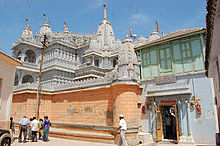
The Dilwara Temples or Delvada Temples are a group of Śvētāmbara Jain temples located about 2+1⁄2 kilometres from the Mount Abu settlement in Sirohi District, Rajasthan's only hill station. The earliest were built by Vimal Shah, a Jain minister of Solanki king of Gurjaratra, Bhima I and additions to the temples were made by Vastupala, Jain minister of Vaghelas of Gurjaratra. They date between the 11th and 16th centuries, forming some of the most famous monuments in the style of Solanki architecture, famous for their use of a very pure white marble and intricate marble carvings. They are managed by Seth Shri Kalyanji Anandji Pedhi, Sirohi and are a pilgrimage place for Jains, and a significant general tourist attraction. The Dilwara temples are regarded as the most impressive among Jain temples in Rajasthan.

Jainism has had a notable following in Gujarat. According to the 2011 Census of India, around 0.959% of the population of Gujarat is Jain. There are several old Jain temples that draw pilgrims from Jains around the world in places such as Palitana, Taranga, Sankheshwar, Idar.

Mangi-Tungi is a prominent twin-pinnacled peak and Digambar Jain Pilgrimage Site, located near Tahrabad about 125 km from Nashik, Maharashtra, India. Mangi, 4,343 ft (1,324 m) high above sea level, is the western pinnacle and Tungi, 4,366 ft (1,331 m) high, the eastern. Mangi-Tungi is 30 km (19 mi) from the city of Satana.

A Jain temple, Derasar or Basadi is the place of worship for Jains, the followers of Jainism. Jain architecture is essentially restricted to temples and monasteries, and Jain buildings generally reflect the prevailing style of the place and time they were built.

Śāntinātha or Śānti is the sixteenth Tīrthaṅkara of Jainism in the present age. According to traditional accounts, he was born to King Vishvasena and Queen Aćira of the Ikshvaku dynasty in the north Indian city of Hastinapur. His birth date is the thirteenth day of the Jyest Krishna month of the Indian calendar. He was also a Chakravarti and a Kamadeva. He ascended to the throne when he was 25 years old. After over 25,000 years on the throne, he became a Jain monk and started his penance.
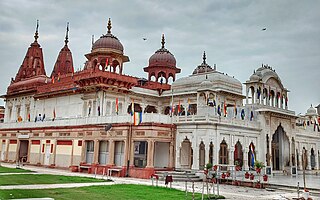
Shri Mahavir Ji is an important and prominent Jain pilgrimage site situated in Shri Mahaveerji town in Hindaun Block, Karauli district in Rajasthan. Given the importance of the religious place, the Indian Railways has specifically developed a railway station under West Central Railway zone by the name of Shri Mahaveerji railway station which is 10 minutes drive from the temple and temple authorities have arranged for regular buses from the station to the temple. The temple is visited by millions of Jain and Hindu devotees every year.
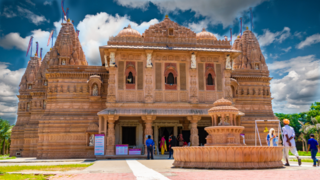
Bhadresar or Bhadreshwar is a village in Mundra Taluka, Kutch district of Gujarat, India. It is about 27 km from Taluka headquarters Mundra and barely a kilometer away from the seashore.
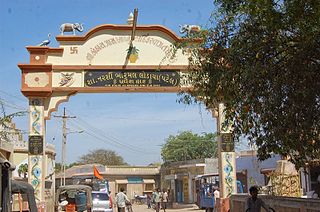
Kothara is a village and a Jain pilgrimage center located in Abdasa Taluka of Kutch district of Gujarat, India.
Tera is a historic village in the Kutch District of the Indian state of Gujarat. It is in Abdasa Taluka, located 13 kilometres (8.1 mi) from the taluka headquarters, Naliya, and 84 kilometres (52 mi) from the district headquarters, Bhuj.

Jain sculptures or Jain idols are the images depicting Tirthankaras. These images are worshiped by the followers of Jainism. The sculpture can depict any of the twenty-four tirthankaras with images depicting Parshvanatha, Rishabhanatha, or Mahāvīra being more popular. Jain sculptures are an example of Jain art. There is a long history of construction of Jain sculptures. Early examples include Lohanipur Torsos which has been regarded to be from the Maurya period, and images from the Kushan period from Mathura.

The Palitana temples, often known only as Palitana, are a large complex of Jain temples located on Shatrunjaya hills near Palitana in Bhavnagar district, Gujarat, India. Also known as "Padliptapur of Kathiawad" in historic texts, the dense collection of almost 900 small shrines and large temples have led many to call Palitana the "city of temples". It is one of the most sacred sites of the Śvetāmbara tradition within Jainism. The earliest temples in the complex date as far back as the 11th century CE.
Suthari is a village in Abdasa Taluka of Kutch district of Gujarat, India.

Bhadreshwar Jain Temple, also known as Vasai Jain Temple, is a historical importance located in Bhadreshwar village of Mundra Taluka, Kutch, Gujarat, India.
Gedi is a village near Rapar of Kutch district of Gujarat, India.
Manjal is a village in Nakhatrana Taluka of Kutch district of Gujarat, India. Nearby ruins of fort and temples of Paddhargadh is historical place associated with legendary Jakh Botera.

There is a group of temples of Jainism on Mount Girnar near Junagadh in Junagadh district, Gujarat, India. While almost all the temples belong to the Śvetāmbara sect, some also belong to the Digambara sect. The hill and some of the temples are considered sacred by both Digambara and the Śvetāmbara branches of Jainism.
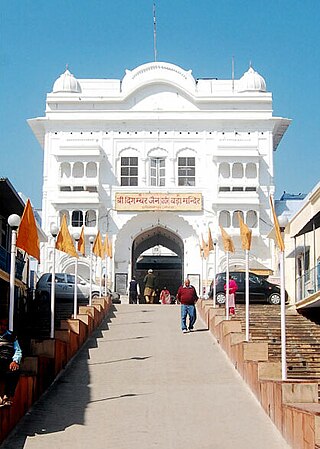
Digamber Jain Bada Mandir Hastinapur is a Jain temple complex located in Hastinapur, Uttar Pradesh. It is the oldest Jain temple in Hastinapur dedicated to Shantinatha, the 16th Jain Tirthankara.

Māru-Gurjarat architecture or Solaṅkī style, is the style of West Indian temple architecture that originated in Gujarat and Rajasthan from the 11th to 13th centuries, under the Chaulukya dynasty. Although originating as a regional style in Hindu temple architecture, it became especially popular in Jain temples, and mainly under Jain patronage later spread across India, then later to diaspora communities around the world.

Kalyansagarsuri was a 16th century Jain ascetic, reformer, philosopher, and researcher belonging to the Achal Gaccha of the Śvetāmbara Murtipujaka sect of Jainism.
